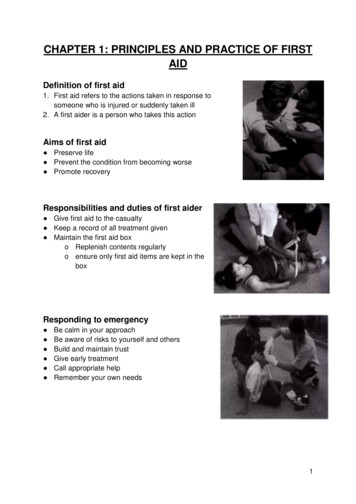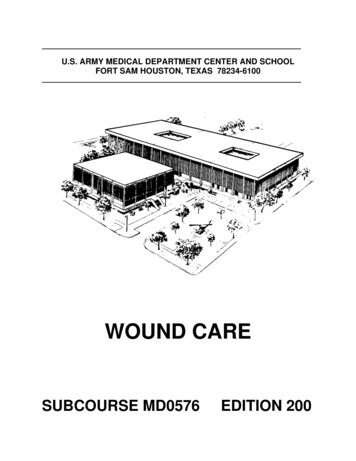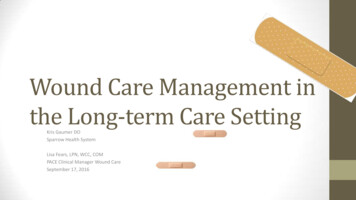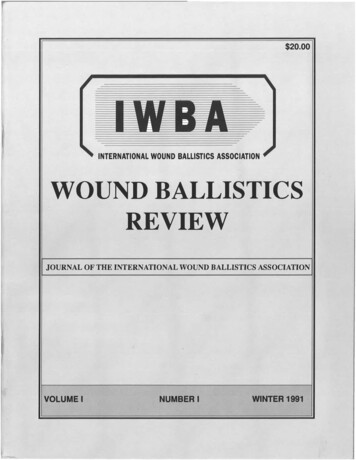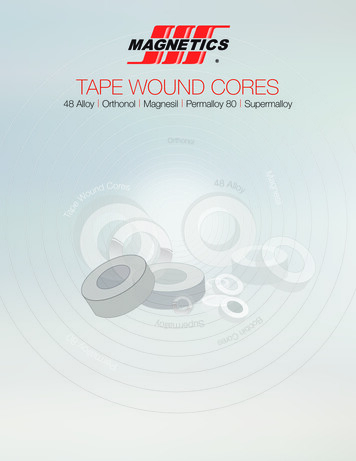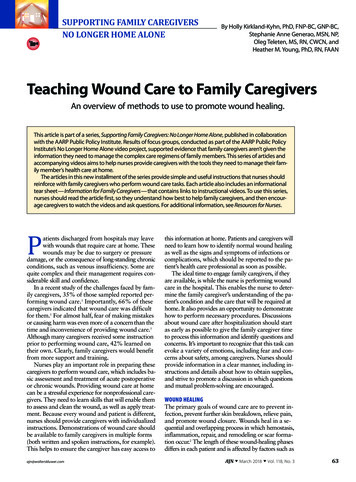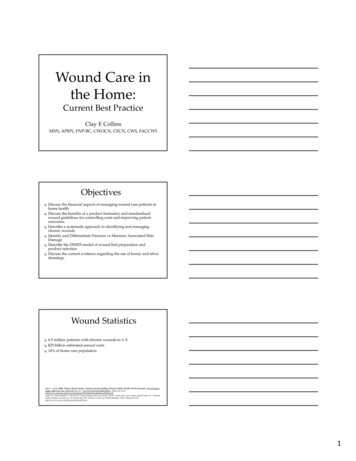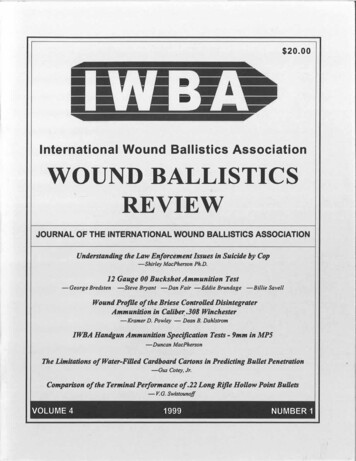
Transcription
20.00International Wound Ballistics AssociationWOUND BALLISTICSREVIEWJOURNAL O.F THE INTERNATIONAL WOUND BALLISTICS ASSOCIATIONUnderstanding the Law Enforcement Issues in Suicide by Cop-Shirley MacPherson Ph.D.12 Gauge 00 Buckshot Ammunition Test-George Bredsten-Steve Bryant-Dan Fair -Eddie Brundage-Billie SavellWound Profile of the Briese Controlled DisintegraterAmmunition in Caliber, .308 Winchester-Kramer D. Powley - Dean B. DahlstromIWBA Handgun Ammunition Specification Tests - 9mm in MP5-Duncan MacPhersonThe Limitations of Water-Filled Cardboard Cartons in Predicting Bullet Penetration-Gus Cotey, Jr.Comparison of the Terminal Performance of.22 Long Rifle Hollow Point Bullets- V.G. SwistounoffVOLUME 41999NUMBER 1
I N F O R M A T I O N F O R A U T HO R Swelcomes manuscripts, articles, short notes and letters to the editor thatcontribute to the science of wound ballistics. Publication preference will lean strongly toward pertinentpapers with clear practical applications. We invite cogent reviews of articles, books, news items, etc.Our goal is to commend good documentation as well as to point out the errors in the wound ballisticsliterature. The Wound Ballistics Review especially requests our readers' help in submitting shortreviews which correct errors noted in the literature.The Wound Ballistics ReviewThe review of all manuscripts reporting original work will be open; the names of reviewers will be givento authors of rejected papers and will be made available upon request to anyone.Articles are accepted only for exclusive publication in IWBA, and when published, the articles andillustrations become the property ofiWBA.WOUND BALLISTICS REVIEWJOURNAL OF THE INTERNATIONAL WOUND BALLISTICS ASSOCIATIONVOLUME 41999NUMBE R 1TABLE O F CONTENTSEditorial.If submitting a letter or review which refutes or points out errors in another work, please provide theaddress of the source (please include a copy of the article reviewed-these will be returned if requested).In submitting original work, the manuscript and one copy are required; one set of high qualityillustrations is required; black and white is preferred. Author's name must be clearly identified on thetitle page with addresses and telephone number. Manuscript must be double-spaced with ample margins(at least one inch on all sides) on standard (8 1/2" x 1 1 ") paper. NOTE: THE PREFERREDMANUSCRIPT FORM IS THE 3 1/2" ( 1 .44 Meg or 720K) PC FLOPPY DISK WITH THE FILE ANDA HARD COPY. Most major PC word processing files are acceptable but WordPerfect or MicrosoftWord are preferred. (Please convert files to WordPerfect 5.1 or 6.0, or to Word for Windows 3.0-7.0.) PLEASE DO NOT PROVIDE COMPUTER TEXT WITH SPECIAL FONTS OR LAYOUTS:PLAIN: SIMPLE TEXT WITHOUT GRAPHICS OR MERGE FIELDS. Any graphs, tables, charts, etc.should be supplied as separate files and/or with a clean, high quality paper copy. Legends for allillustrations should be listed in order, double-spaced. An abstract of 1 50 words or less should precedethe text.Questions and Comments . . . . . . . . . . . . . . . . . . . . . . . . . . . . . . . . . . . . . . . . . . . . . . . . . . . . . . . . . . .34Understanding the Law Enforcement Issues in Suicide by Cop . . . . . . . . . 18. .-Shirley MacPherson, Ph.D.12 Gauge 00 Buckshot Ammunition Test . . . . . .-George Bredsten-Steve Bryant-Eddie Brundage-Billie Savell. . . . . . . . . . 22.-Dan FairWound Profile of the Briese Controlled Disintegrater Ammunitionin Caliber .308 Winchester . . . . . . . . . . . . . . . . . . . 25. . .-Kramer D. Powley - Dean B. DahlstromIWBA Handgun Ammunition Specification Tests - 9mm in MP5. . . .References are to be numbered sequentially within the text and appear in the order cited at the conclusionof the article. Page numbers must be given in books, cited as references. . . . . 29- Duncan MacPhersonThe Limitations of Water-Filled Cardboard CartonsEXAMPLES :1. Book: Broad W, Wade N, Betrayers of the Truth. New York,Simon & Schuster, 1 982, p 1 922. Article in periodical: Fackler ML, Surinchak JS, Malinowski JA, et al. Bulletfragmentation: A major cause oftissue disruption. J Trauma 1984;24:263-266.Articles submitted for publication consideration should be sent directly to the Editor-in-Chief:Dr. Martin L. Fackler, 2 1 1 Star Lake Drive, Hawthorne, FL 32640in Predicting Bullet Penetration . . . . . . . . . . . . . . . . . . . . . . . . . . . . . . . . . . . . . . . . . . . . . . . . . . . . . . . . . . . . . . . . . . . . . . . . . . . . . . . . . . . . .30-Gus Cotey, Jr.Comparison of the Terminal Performance of.22 Long Rifle Hollow Point Bullets . . . . . . .36-V.G. SwistounoffBook Review. . . . . . . . . . . . . . . . . .Vol 4,No. 1. . .471
.JOURNAL OF THE INTERNATIONAL WOUND BALLISTICS ASSOCIATIONThe International Wound Ballistics Association (IWBA) is an IRS 501(c)(3) non-profitscientific, educational, and public benefit California corporation with Federal 10#94-3136817.The IWBA is devoted to the medical and techrical study of wound ballistics, includingevaluation of literature in the field as well as encouraging and promoting new work.The WOUND BALLISTICS REVIEW is the Journal of the IWBA.Dr. Martin FacklerTorrey D. JohnsonWound Ballistics ConsultantBallistics ConsultantCriminalistGainseville, FLPinole, CALas Vegas NVPeter G. KokalisDouglas Lindsey, MD, DrPHFirearms ConsultantProfessor of Surgery, EmeritusPhoenix,AZCortaro, AZtridges loaded with Matchking bullets that have a hol About This IssueBoard of DirectorsAlexander JasonWe are especially happy to present, in this is low point hole in the 0.020 inch range, they will besue, the article on "Suicide by Cop" by Shirley Mac stuck with a bullet that performs erratically - a disasterPherson, PhD, a mental health professional. This sub waiting to happen.ject got national attention recently, when it was pre large law enforcement purchasers specify to the bulletsented on one of the major TV news magazine pro supplier that the 30 caliber Matchkings they purchasegrams (NBC ' s Dateline, I believe) within the past fewmust have a hollow point hole of 0.60 to 0.70 inch.Thather authoritative and well written article is one thatproblem while still retaining the inherent accuracy ofthe Matchking bullet. We work hard in the IWBA totry to help the law enforcement community, but thereIn the past six months we have had severalis a point at which they have to take the initiative inEngineering Consultantquestions submitted by members that we felt war applying the information supplied and help them El Segundo,CAranted special attention. These questions, about theselves.Duncan MacPhersoneffects of rifle versus handgun bullets, about "shockMembers who seek reliable information onwaves" associated with bullet penetration, and aboutballistics should be sure to read the book review in thisissue.Chief Medical ExaminerCriminalistquently but rarely answered precisely. We felt thatSanta Cruz, CASan Diego,CAthese topics deserved authoritative and comprehensiveanswers, so we put a lot of effort into attempting tofurnish them. We hope we clarified these issues andpossibly provided a source to which others can refer inthe future for clear answers to these questions whenWOUND BALLISTICS REVIEWthe subject come up again. We thank these membersfor providing the insightful and pertinent questions andJournal of the International Wound Ballistics Associationhope others will notice their example and continue toIWBA. All Rights Reservedgive us the chance to clarify difficult issues. We like tothink of our questions and comments section one ofEditor-in-Chief: Martin L. FacklerProduction Manager: Duncan MacPhersonthe most valuable parts of theWound Ballistics Re-view.The Briese bullet (testing described on pagesDesign & Production -Townsend Document & Designsistent performance of the 168 grain Sierra MatchkingWOUND BALL ISTICS REVIEW is issued twice a year. Subscriptions are included withmembership, but are available without membership. Dues are 40 for 4 issues of the IWBAJournal for both members and subscribers. Four issue mailing cost surcharges of 8.bullet, as pointed out previously in this journal (Vol 2,for Canadianfor other foreign addresses are required with the dues.I 1(310) 640-6065.vNo. 1interested in anywellmunition that has been rated against the IWBA Hand gun Ammunition Specification. We are not interestedin any "one shot stop" nonsense, but want to knowhow this ammunition expanded in actual use. We needto know what materials were penetrated prior to tissuecontact, what part of the body was struck, whetherbone was hit, and (if possible) the length of the woundtrack. Please contact theIWBA office if you have anysuch information.The.224BOZThe November 1998Guns and Ammohas acover article on the.224 BOZ and the article shows thatG&A thinks very highly of this development. WhileG&A cover claims their report is an "Internationalthese articles, It was also pointed out that this incon Exclusive", members may recall a substantially lesssistency could be very easily eliminated - simply byenthusiastic assessment reported six months earlier inenlarging the hole in the Matchking's tip. But it is upthe V3#3 Wound Ballistics Review.cit of the Matchking be fixed by those who sell thebullet. Sierra will make the Matchking with any sizehole the buyer wants (personal communication withKevin Thomas, Chief ofBallistics at Sierra, 1995). ButVol 4,are extremelytheso long as law enforcement continues to buy the car-2Wedocumented shooting results involving handgun am #2, 1995, pp. 8-12. and Vol 2 #4, 1996, pp. 22-24). Into the law enforcement users to demand that this defi All matters related to membership should be directed to:Box 701, El Segundo, CA 90245-701; TelephoneFeedback25-28) was probably invented because of the incon TheIWBA, POinconsistent performanceforcement community.the efficacy of shots to the pelvic area, are asked fre 18.should solve theirwill provide some badly needed help to the law en Eugene Wolbergand Mexican addresses andIt is about time that some of themonths. I think the perspective that Shirley presents inRichard Mason, MDISSN 1055-0305 Copyright 1995,EditorialJOURNAL OF THE INTERNATIONAL WOUND BALLISTICS ASSOCIATIONEDITORIALIWB A ORGANIZAT IONMartin L. Fackler, MDWOUND BALLISTICS REVIEWVol 4, No. 1Web PageWe have just begun to work on an internetweb site for theIWBA. No details are available yet,but we expect to be able to introduce the web site withall the necessary information in the next issue.3
WOUND BALLISTICS REVIEWQuestions a n d Comme nts------JOURNAL OF THE INTERNATIONAL WOUND BALLISTICS ASSOCIATIONQUESTIONS AND COMMENTSIncapacitation TimeQUESTIONI was introduced to Dr. Fackler' s studies byBob Kong at a range instructor school I attended sometime ago. Since then I have joined the IWBA and haveread everything I could about would ballistics. I havea question, and believe your group can easily answer itin a manner I can understand and pass on to my fellowofficers and range instructors.Assumption: Wounds that do not interrupt theCNS can permit the subject to function until the brainno longer has enough oxygen to operate. Questionsbased on above assumption:Does the rate at which blood loss from a non-CNS1.hit occurs affect the probable time to incapacita tion?2.Would one expect the time to incapacitation togenerally be shorter for a non-CNS chest shotfrom a .308 than a similarly located shot from a.223 or .45 ACP?Is there a level/quantity of non-CNS tissue damage3.that can be expected to cause near-instantaneousincapacitation?If increasing the amount of non-CNS tissue dam 4.age decreases probable time to incapacitation, is itvia increased rate of blood loss or some othermechanism? I thought the idea behind the subjectcontinuing to operate for several seconds was thatthe oxygen was already in the brain. That wouldseem to suggest it wouldn't matter what happenedto the rest of the circulatory system.I don't expect answers to these questions one-by one. That would presume that the questions were in dependent of each other and required (or deserved)separate answers. I realize they say the same thing,from perhaps a slightly different angle.Whatever light you can shed on this issuewould be most appreciated. I'm trying to begin devel oping myself as a resident wound ballistics "expert"within the department. It's tough when someone asks,"How come I heart-shot a dear, and he dropped in histracks?" I'm comfortable saying handgun rounds can'tbe counted ori to incapacitate immediately apart fromCNS hits. I don't know about rifle hits. Does a non-4WOUND BALLISTICS REVIEWCNS .308 or .233 hit destroy so much tissue that thebody shuts down despite there being oxygen in thebrain?Your assistance would be much appreciated.Todd WilcoxANSWERWe can't "easily" answer Officer Wilcox'squestions, but I believe we can answer them in a man ner that will be clear and easily understood. These aresome of the very best questions we have ever hadsubmitted, and present an opportunity to clarify somepoints that are critical to a good comprehension ofwound ballistics.First, the "Assumption" in the question,"Wounds that do not interrupt the CNS can permitthe subject to function until the brain no longer hasis basically correct. Onecould think of exceptions, however, such as a personwho has had both hands inactivated by projectile hitsin the hand or the arm, or from interruption of the ca pacity of peripheral nerves (not a part of the centralnervous system [CNS]) to carry impulses to musclescontrolling the hand. Such a person could not fire agun. So that particular function could be obliteratedwithout a CNS hit. Likewise, the function of running,or even standing upright, can be stopped by bullet hitsto major bones of the leg. So certain specific functionscan be interrupted by localized non-CNS hits; but aCNS disruption will cause immediate total shut downof all functions.enough oxygen to operate."Questions based on the assumption:1. "Does the rate at which blood loss from a non CNS hit occurs affect the probable time to incapaci tation?"Basically, yes. The only exceptions would beif the heart's output was interrupted by destruction ofthe heart itself (a 1 2 gauge shotgun hit from a few feet,for example), or by interruption of the blood pathwayfrom the heart to the brain: if the blood flow from theheart to the brain was stopped by a projectile destroy ing the aorta just after it leaves the heart. The fastestphysiological non-CNS incapacitation (about ten sec onds) from a gunshot would be most likely to occur inVol 4,No. 1JOURNAL OF THE INTERNATIONAL WOUND BALLISTICS ASSOCIATIONthese circumstances. In all other cases the rate of bloodloss would most likely be the major determining fac tor.The size of the blood vessel and the size of thehole (or holes) in blood vessels would both determinethe rate of blood loss, as would the pressure in the ves sels: the same size hole in a major artery will usuallylose blood faster than if the hole is in a major vein,because the pressure is much lower in veins. Body de fense mechanisms such as reduction in the diameter ofblood vessels by constriction of the muscle fibers intheir walls, and diminution or blockage of blood lossby the formation of blood clots, as well as pressure onthe injured vessel from neighboring anatomic struc tures, can all act to decrease or stop blood loss. For amore complete handling of incapacitation from bloodloss see Newgardt.Why did I add "most likely," and "major"above? . . . . and not simply declare unequivocally thatthe rate of blood loss would be the determining factor?Because there are other largely overlooked but ex ceedingly important factors that we cannot ignore. Oneis a conscious decision of the person hit to stop hisaggression. True, this is not physiological incapacita tion, but in a gunfight, the observed reaction from aloss of the will to continue can be indistinguishablefrom a true physiological incapacitation (from bloodloss, etc.) in the short term. There is a wide spectrumof changes that affect the human in a stressful situation- especially one that is perceived as life-threatening:tunnel vision, decreased hearing perception (nearbygunshots are heard as mild "pops" or are shut out alto gether), the perception of time slowing (events seem tooccur in "slow motion"), etc. These are known fromsubjective reports, and, so far as I know, no attempthas yet been made to measure, or even identify, theprecise neurologic mechanisms that cause them. Thereare a myriad ill-defined and not well understood psy chological gradations between the simple purely con scious decision to quit, and the total collapse frompsychologically created subconscious factors thatcause a true physiological (loss of blood pressure) in capacitation, the mechanism of which is describedbelow.The subconscious psychological reaction thatcan create transient incapacitation by altering thephysiology without damaging it is called neurogenicshock. Let me illustrate with an example: As a seniorVol 4,No. 1-in high school, I went to my dentist with extreme painin a tooth. I had an infection under an intact filling the tooth had to be removed. The dentist did a man dibular nerve block, which achieved total anesthesia ofthe area, and proceeded to pull the tooth. I had no pain,but could perceive the tissues being torn as the toothwas separating. I became extremely light-headed andprobably fainted - or nearly so. What was the physio logical mechanism for my temporary incapacitation? Ihad not lost a significant amount of blood. It was notan allergic reaction to the lidocaine used for the nerveblock. It was not a result of a spreading of the infec tion into my entire circulation. But there had to be areason for this sudden total incapacitation of a healthyyoung man. What was it? It was the physiologicalmechanism, with a psychological cause, known asneurogenic shock - more specifically the type of neu rogenic shock called "Emotional fainting"2 Strongemotions (such as fear) can cause widespread dilationof the body' s blood vessels. These vessels have musclefibers in their walls which allow them to constrict ordilate and thus vary blood flow as needed (in responseto heat and cold, for example). The vessels are usuallykept semi-constricted, but in Emotional Fainting,nerve impulses from the sympathetic nervous systemcan cause them to dilate completely. When this hap pens, the vascular capacity increases substantially andthe blood available can no longer fill it. If the person isupright when this happens, gravity pulls the availableblood into the legs and lower torso, starving the brainand causing the incapacitation.Neurogenic shock or Emotional Fainting iswell documented and occurs probably much more of ten than is recognized. Ask Kevin Thomas, Chief ofBallistics at Sierra Bullets, about the shooting incidentthat occurred when he was a police officer. He hadoccasion to shoot and his opponent fell immediately.He thought this must certainly be the result of a CNShit. It was, in fact, the result of a miss - the bullet hadnot hit the fellow but he obviously thought it had - and that thought caused his immediate collapse. Kevinpublished this incident, but I can no longer rememberthe reference. Anybody who has had occasion to re view significant numbers of shooting incidents in de tail has seen examples of this phenomenon - maybe insome cases it is not a miss but a graze or minor woundcausing an unexplained major collapse.5
-------WOUND BALLISTICS REVIEWWOUND BALLISTICS REVIEWQu estions and CommentsQuesti ons and CommentsJOURNAL O F THE INTERNATIONAL WOUND BALLISTICS ASSOCIATIONJOURNAL OF THE INTERNATIONAL WOUND BALLISTICS ASSOCIATIONThere is no question in my mind that the ef To illustrate that principle I will answer thisit weren't for the inherent variation in the distance themade by its reliable expansion -- with cutting edges onfects of Emotional Fainting, or some gradation of psy question in several ways: first, I will give the mostbullet penetrates before it yaws (then breaks and frag the expanded bullet, coupled with its reliable penetra chologically caused incapacitation (the gamut fromlogical answer, considering the question came from aments)- about seven-in-ten times it yaws after four totion to an adequate depth of 1 2 inches. With the po tentially acceptable .223s shot from a short barrel, Isurrender to Emotional Fainting), are either totally orlaw enforcement source. I will assume that the .308six inches, but in the remainder it yaws sooner - orpartially responsible for much more of the observedbullet is a 168 grain Sierra Matchking (which I think islater - in its penetration. Many of the fragmentingreaction from bullet hits than is recognized.The prac tical result of this misinterpretation of the causes ofreactions to being shot is its overwhelming con founding effect on any attempt to compare the effi cacy of various bullets by observing, recording, andcomparing the reactions of those hit.by far the most common bullet used in that cartridge. 223s would be fine for precise placement at a specificby law enforcement), I will assume that the .223 is awell-chosen point in the human anatomy by a snipernonfragmenting bullet such as the Federal Tacticalusing a rifle producing half-minute accuracy. But the3. Is there a level/quantity of non-CNS tissue dam round (which several sources tell me has been the un inherent shallow penetration of these bullets wouldagefortunate choice of many law enforcement groups),make them unsuitable for fast shooting when theyinstantaneous incapacitation?and I will assume that the .45 ACP bullet is a 230might be required to perforate an arm before strikingNo, only direct or indirect CNS tissue damageIt seems likely that Emotional Fainting is moregrain hollow point which expands reliably and has athe torso . The best compromise would probably be onecan be expected to cause nearly instantaneous com common in the scared-to-death petty criminal than injacket that folds back and forms cutting edges whichof the heavier .223s that fragments some but has a coreplete incapacitation. I think the question implies a hitthe seasoned and well-trained terrorist. If that is so, itadd to the tissue disruption the expanded bullet pro that holds together for adequate penetration (the Win in which the bullet does not actually strike the CNS.appears to be a lucky break for law enforcement, who,duces (such as either the Winchester SXT or thechester 64 grain soft point comes to mind). PleaseBut let us not forget that indirect "CNS tissue damage"in most of their gunfights will then be facing thoseRemington Golden Saber -- in this caliber, at least,note, I am assuming that these bullets will be firedcan also be produced by bullets that do not strike thesusceptible to overreacting to being hit- or sometimesmost law enforcement groups seem to have made afrom a barrel with a minimum length of 20 inches.even to being missed. There is, however, a large de valid bullet choice) .would expect the time to incapacitation to be longer·than that of the .45 ACP.thatcanbeexpectedtocausenear- CNS directly -- by sudden violent motion transmittedWe must remember that the .223 is a varmintto the bones of the spine, which cover and protect thecartridge, never intended for use against animals thespinal cord from the temporary cavity produced by agree of uncertainty about the type of person who mightI would expect the time to incapacitation gen be more susceptible to the Emotional Fainting. That iterally to be shortest for .45 ACP, second for the .308size of the adult human. And law enforcement groupsbullet, provided the cavity is large enough . I wouldoccurs is certain, its physiology is clear: to whom itand longest for the nonfragmenting .2233 Some mightare adopting it in ridiculously short barrel lengths ( 1 6,expect a temporary cavity as large in diameter as theoccurs, how much of their reaction might be due to it,argue that I have chosen the most effective bullets14 .5, and even 9.5 inches) which decrease significantlyfront-to-hack diameter of the human chest (about tenand under what circumstances it is most likely to oc available in the .45 ACP and compared them withits already marginal performance. Bullets from a .223inches; 1 4 inches side-to-side) might cause instantane ous incapacitation in many torso hits:cur, however, is far from certain. It will probably helpbullets for the two other cartridges that are substan will do the job reliably only when the bullet is placedyou in a gunfight, but it is unpredictable- don't countdard, and therefore this skews the answer . Such an ar with surgical precision - as it can be from a 24 inchon it . You need to know about this factor, however, ifgument is entirely correct. But my choices were madeheavy barrel on a bolt action scoped rifle. I'm afraidyou want to have a good, practical, and comprehensiveto reflect the irrational bullet choices currently beingthat if law enforcement groups continue to use theSuch a temporary cavity would be large enough so thatunderstanding of wound ballistics.made by the majority of law enforcement groups. Are.223, with short barrels, as a spray-and-pray gun forit could cause the spine to be moved violently andthese rounds the ones I would choose to take best ad entry purposes they will find out the hard way - byabruptly, causing the spinal cord to be struck by the2. "Would one expect the time to incapacitation tovantage of the cartridges named? In the .45 ACP, yes:losing officer lives unnecessarily - that it is not up towall of the spinal canal and causing a "concussion ofgenerally be shorter for a non-CNS chest shot fromfor the other two cartridges, a resounding No.what they are expecting of it. The cartridge justthe spinal cord" which affects the cord, transiently atdoesn't have the power to provide a safety margin -least, as if it had been cut: it would cause immediateeverything must be done exactly right for the littleincapacitation of the muscles innervated by nerves thata .308 than for a similarly located shot from a .223Now, I will answer the question assuming inall cartridges the most effective bullet available isor .45 ACP?"It is impossible to give an accurate answerwithout knowing what kind of bullets are being used ineach caliber. For the past half century I have beenreading about small arms and their effects. The greatmajority of the "experts" are strongly wedded to theirideas on which cartridge is best for a particular pur pose. Their strongly held opinions, many based onwide experience, are often opposed by just as stronglyheld opinions of other well-qualified "experts" whoused. These would be: in the .308, a bullet that frag ments reliably, like 168 grain Sierra Matchkingor dered/rom Sierra with a 0.060 inch or larger diame ter hole in its tip. Please understand, this bullet isavailable - but not in small quantities - large depart ments must demand from their suppliers that they or der these large-hole bullets from Sierra and load themrather than the ones with the tiny holes that are regu larly supplied. Erratic performance with the currentgenerallytiny-hole Matchkings (mostly they act like FMJs) isoverlook the single most critical principle, the crux, ofwell documented, as is the method of eliminating thewound ballistics:problem by enlarging the hole4-6.preferanothercartridge.Theseexpertsthe design and construction of thebullet is by far the most important element deter mining its wounding capacity. The cartridge or caliberis clearly of secondary significance.6In the .223 cartridge, I have great difficultyidentifying the most effective bullet. Every choice is acompromise. The military ball round would be fine ifVol 4,No. 1but it is difficultto view this as "non-CNS" since the mechanism ofincapacitation is, in fact, from CNS tissue damage.varmint round to give acceptable results on the humancome from the spinal cord at or below the level of thetarget.concussion. What this means is that many torso hitsOK, now let me answer the question assumingcould cause incapacitation of the muscles of the legs -a reliably fragmenting .308 bullet, which can be madebut would be unlikely to incapacitate the muscles ofeasily by enlarging the HP hole in the Sierra Match the arms (which are innervated predominantly byking to at least 0 .060 inch, one of the best availablenerves emerging from the spinal cord in the neck).223s , and the .45 ACP loaded with a 230 grain cut I recall an article in which a gun writer de ting action hollow point bullet. I would expect the timescribed shots into the torsos of prairie dogs made withto incapacitation generally to be shortest for the .308hollow point handgun bullets . He reported that someby a large margin. I would expect there to be no clear of these hits had literally blown these tiny animals incut difference between the .223 and the 45 ACP: thehalf . He used this to argue that the temporary cavity of.223 might have more spectacular successes - whichthe handgun was therefore of awesome power andwould be counterbalanced by just as many spectacularcould not be regarded as ineffectual for shots in thefailures - but I would expect the 45 to be the more re human torso. This writer lacked a sense of perspectiveliable overall because of the large permanent holeand proportionality: he overlooked the all-importantVol 4,No. 17
WOUND BALLISTICS REVIEWWOUND BALLISTICS REVIEW-Questions a n d Commen tsJOURNA
sistent performance of the 168 grain Sierra Matchking bullet, as pointed out previously in this journal (Vol 2, #2, 1995, pp. 8-12. and Vol 2 #4, 1996, pp. 22-24). In these articles, It was also pointed out that this incon sistency could be very easily eliminated -simply b
